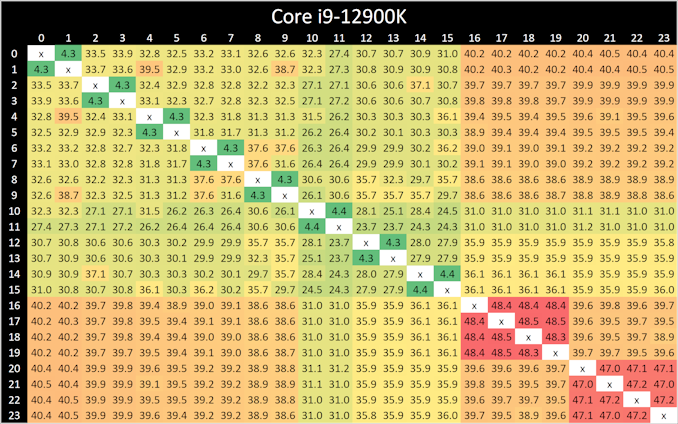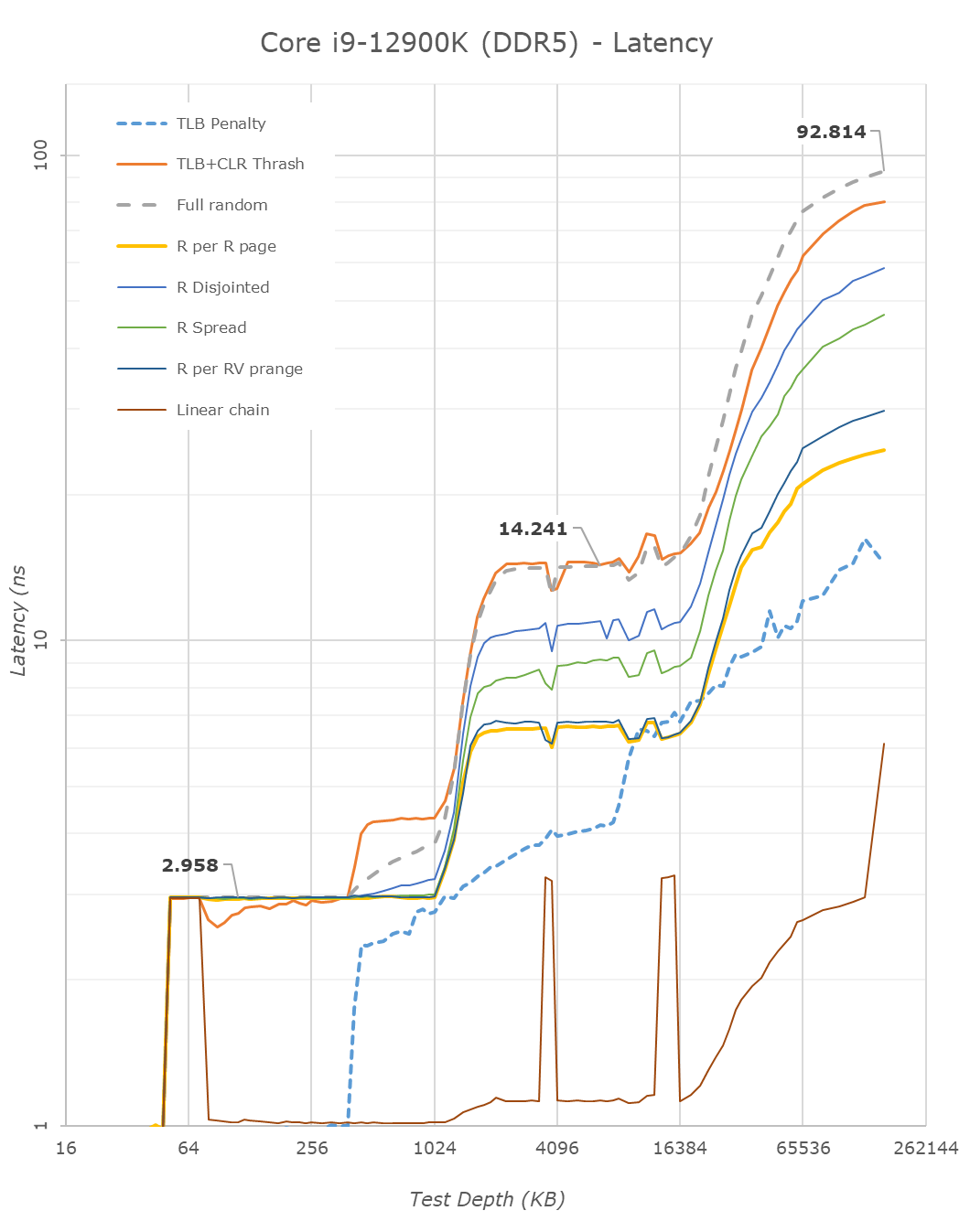The Intel 12th Gen Core i9-12900K Review: Hybrid Performance Brings Hybrid Complexity
by Dr. Ian Cutress & Andrei Frumusanu on November 4, 2021 9:00 AM ESTCPU Tests: Core-to-Core and Cache Latency, DDR4 vs DDR5
Starting off with the first of our synthetic tests, we’re looking into the memory subsystem of Alder Lake-S, as Intel has now included a great deal of changes to the microarchitecture, both on a chip-level, as well as on a platform-level due to the new DDR5 memory compatibility.
In our core-to-core latency test which showcases the physical topology of the chip, there’s a few things to note. Beginning with the P-cores, which are logically enumerated in the operating system as cores 0 to 15, we can see that latencies are about the same as what we’ve seen on Rocket Lake, although with a few nanosecond differences in the results. The latencies appear to be a bit more topologically uniform, which might indicate that Intel might have finally gotten rid of their uni-directional coherency snoop ring for a bi-directional one.
Latencies between the SMT siblings are also interesting as they decrease from 5.2ns on the Willow Cove cores to 4.3ns on the new Golden Cove cores. The actual L1 access latencies haven’t changed between the two microarchitectures, which means that Intel has improved the LOCK instruction cycle latency.
Between the Golden Cove cores and the smaller Gracemont cores we see higher latencies, as that was to be expected given their lower clock speeds and possible higher L2 overhead of the Gracemont cluster.
What’s however a bit perplexing is that the core-to-core latencies between Gracemont cores is extremely slow, and that’s quite unintuitive as one would have expected coherency between them to be isolated purely on their local L2 cluster. Instead, what seems to be happening is that even between two cores in a cluster, requests have to travel out to the L3 ring, and come back to the very same pathway. That’s quite weird, and we don’t have a good explanation as to why Intel would do this.
Cache Latencies and DDR5 vs DDR4
Next up, let’s take a look at the new cache hierarchy of Alder Lake, both from the view of the Golden Cove cores as well as the Gracemont cores, in DDR5 as well as DDR4.
Alder Lake changes up the big cores cache quite considerably. First off, the L1D remains identical – so not much to report there.
On the L2 side of things, compared to Rocket Lake’s Willow Cove cores, Alder Lake’s Golden Cove cores considerably increase the L2 cache from 512KB to 1.25MB. This does come at a 15% latency degradation for this cache, however given the 2.5x increase in size and thus higher hit rates, it’s a good compromise to make.
The Gracemont E-cores have a large 2MB L2 which is shared amongst the 4 cores in a cluster, so things do look quite differently in terms of hierarchy. Here latencies after 192KB do increase for some patterns as it exceeds the 48-page L1 TLB of the cores. Same thing happens at 8MB as the 1024-page L2 TLB is exceeded.
The L3 cache of the chip increases vastly from 16MB in RKL to 30MB in ADL. This increase also does come with a latency increase – at equal test depth, up from 11.59ns to 14.24ns. Intel’s ring and cache slice approach remains considerably slower than AMD’s CCX, which at a similar L3 size of 32MB comes in at 10.34ns for equivalent random-access patterns.
On the DRAM side of things, we can start off with the RKL DDR4 to ADL DDR4 results. The memory latency at 160MB goes up from 85ns to 90ns – generally expected given the larger memory subsystem of the new chip.
Shifting over from DDR4 to the DDR5 results on Alder Lake, at JEDEC speeds, comparing DDR4-3200 CL20 to DDR4-4800 CL40, the officially supported speeds of the chip, we see memory latency only go up to 92.8ns, which is actually below our expectations. In other prefetcher-friendly patterns, latency goes up by a larger 5ns, but still that’s all within reasonable figures, and means that DDR5 latency regressions we feared are overblown, and the chip is able to take advantage of the new memory type without any larger issues.
We only ever whip out our memory level parallelism test when there’s a brand-new microarchitecture which changes things quite considerably in regards to how it handles MLP. Alder Lake and its Golden Cove and Gracemont cores are such designs.
Memory level parallelism is the characteristic of a CPU being able to have multiple pending memory accesses – instead of doing things serially, out of order CPUs are able to fetch data from multiple memory locations at the same time. The definition of how many accesses this ends up as, depends on the design within the core, such as MHSR’s, but also the actual parallelism of the various caches as well as the fabric itself. Our test here compares the relative speedup of doing parallel access of random pointer chain chasing – a speedup of 2x means that the core is able to access two chains simultaneously with no degradation of per-element access times. At some point, we’ll be hitting bottlenecks of the various memory elements of the core and memory subsystem. A higher MLP speedup allows for faster execution in workloads which have data-level parallelism, and also improves the ability to hide latency in terms of performance.
Intel’s Golden Cove core is here a massive uplift in terms of its MLP capabilities. The L2 cache of the chip, because it’s so much larger, likely also has a lot more physical banks to it, likely allowing more parallel accesses.
On the L3 cache, Intel also notably mentioned that the new design is able to handle more outstanding transfers, as we immediately see this in the results of Golden Cove. Our test here only tracked up to 30 parallel accesses and we didn’t have time to check out a more extended test, but it does seem the core would be able to hit higher figures – at least until it hits TLB limits, where things slow down. The MLP capabilities here are similar, if not greater, than what AMD showcases in their Zen CPUs, something we had noted as being a strength of their microarchitecture.
MLP at deeper DRAM regions is essentially double that of Rocket Lake – at least on the DDR5 variant of Alder Lake. The DDR4 results reduce the MLP advantage, likely because the chip has to deal with only 2 memory channels rather than 4 on the DDR5 test, this allows the DDR5 variant more parallel sparse accesses to DRAM banks. Interestingly, Intel still doesn’t do as well as AMD even with DDR5 – I’m not sure where exactly the differences stem from, but it must be further down the fabric and memory controller side of things.
From the E-core Gracemont cores, the results also look good, albeit the L3 parallelism looks lower – maybe that’s a limit of the outstanding requests from the L2 cluster of the GRM cores – or maybe some interface limitation.
I think the MLP improvements of Alder Lake here are extremely massive, and represent a major jump in terms of memory performance of the design, something which undoubtedly lead to larger IPC gains for the new microarchitecture.













474 Comments
View All Comments
adamxpeter - Friday, November 5, 2021 - link
Very poetic post.bananaforscale - Friday, November 5, 2021 - link
Seems we're actually getting a Zen 3 refresh early next year. Alder Lake's lead also decreases with DDR4, gaming above 1080p (so basically anyone who would buy a 12900K for a gaming rig), it uses more power and with DDR5 you pay extra for memory.Yeah, Alder Lake has some advantages. Not sure I'd call it a better overall package at the moment.
madseven7 - Saturday, November 6, 2021 - link
Intel is back at the cost of power. AMD at that power will destroy Intel. Intel basically said screw TDP.Qasar - Saturday, November 6, 2021 - link
intel has been saying that for 2-3 years now, its the only way their chips can be competitive with zen 2 and 3Maverick009 - Sunday, November 7, 2021 - link
They really haven't screwed up as you would like to think. I do believe AMD was thrown off some by the unexpected performance in Hybrid design. They still do trade blows between some games, multi-threaded software, and on applications that are just not optimized for Alder Lake.What I have noticed though in the days since Alder Lake's NDA went up and reviews came out, is leaks to AMD's next gen Zen CPUs have begun to trinkle out a little more than usual. Yes we have Zen 4 on the way, which will pave the way for DDR5 and PCIe Gen5 along with an uplift in IPC. However the real secret sauce may be in Zen 4D as the platform to build a heavily multi-threaded core package along with SMT enabled, and then Zen 5. The big picture, is AMD's version of a Hybrid CPU may include a combination of Zen 4D big cores and Zen 5 Bigger cores. The Zen 4D are said to possibly carry as many as 16 cores per chiplet, too, so it would speak to a possible heavily multi-threaded efficient CPU, while sacrificing a little bit of single threaded performance to achieve it. The timeframe would also put the new Hybrid CPU on a collision course to battle Raptor Lake.
For once the CPU market has gotten interesting again, and the consumer ultimately wins here.
NikosD - Monday, November 8, 2021 - link
@reviewersSince AVX-512 is working on ADL, it would be useful to test the AVX-512 vs AVX2 power consumption of ADL by running POVRAY using P-cores only and compare that maximum AVX2 power consumption to AVX-512 max power consumption using 3DPM.
Because max 272W power consumption of POVRAY as reported, includes 48W from E-cores too.
mode_13h - Tuesday, November 9, 2021 - link
> it would be useful to test the AVX-512 vs AVX2 power consumption of ADL by running POVRAYI'm not sure of POV-Ray is the best way to stress AVX-512.
NikosD - Wednesday, November 10, 2021 - link
They have already tested max power consumption of AVX-512 using 3DPM.I just asked to test POVRAY using P-cores only, for max power consumption of AVX2 in order to compare with 3DPM.
usernametaken76 - Monday, November 8, 2021 - link
lolxhris4747 - Tuesday, November 9, 2021 - link
They did not take the performance crown gaming is almost tied overall mt is a mixed bag hopefully they use pbo which gives about 27k-30k on c23